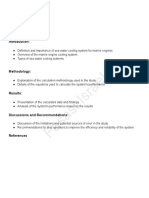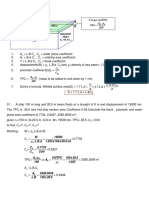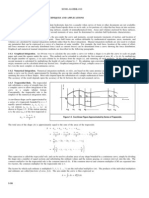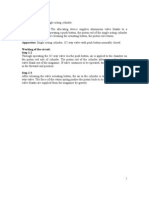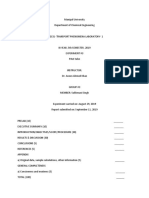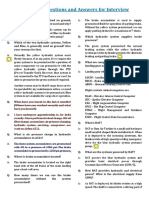Axial Momentum Theory
Axial Momentum Theory
Uploaded by
manikandan_murugaiahCopyright:
Available Formats
Axial Momentum Theory
Axial Momentum Theory
Uploaded by
manikandan_murugaiahCopyright
Available Formats
Share this document
Did you find this document useful?
Is this content inappropriate?
Copyright:
Available Formats
Axial Momentum Theory
Axial Momentum Theory
Uploaded by
manikandan_murugaiahCopyright:
Available Formats
Axial Momentum Theory: Axial Momentum theory tells how the propeller works.
In this theory propeller is considered as an actuator disc or circular disc, instead of consisting of blades which is rotating in air. The action of the actuator disc is to increase the pressure field in the fluid across the propeller disc. Therefore the disc generates the thrust. In this theory how the propeller changes the pressure field is not explained. There is an assumption that the pressure field changes across the disc. The fluid which passes through the still disc with velocity called free stream velocity. Free stream velocity is equal and opposite to the forward propeller.
Figure 1-Actuator Disc P0 Initial pressure value at upstream and downstream of the propeller Pressure drops down to the negative value P1 and then increases to due to the action of propeller to P2. After passes through the propeller the pressure drops to initial value. When there is change in pressure there will be change in velocity. Velocity is gradually increasing in the flow due to continuity there will not be abrupt change across the disc.
V1= Increament velocity at the disc; V2 = Increament velocity at downstream. Assume that the velocity is constant across the disc (i.e. V+V1 is constant). Here only the velocity change in axial direction is considered. Mass of fluid passing through the disc = Then Thrust produced by the propeller = [( ) ] ( ) ( ) ( )
Rate of change of momentum in the entire fluid gives the thrust force generated in the propeller. Substitute the Value of mass in equation (2), we get ( )
Power delivered by the propeller = Work done by the thrust = ( ) ( )
Work done by the thrust = Rate of change of Kinetic Energy [( ( ) )[ ] ] ( )
( ( ) ( ) ( ( [ ]
) [ ) ) (
] ( ) )
( ) From the final equation, increament in velocity at the disc is half of the downstream velocity. In non-dimensional form, ( )
Propeller efficiency:
Output power = Power used by the aircraft. ( ) ( )
Where
( )
Design Engineers always try to increase the efficiency of the propeller. From the above conditions a is always positive but less than one. always less than one. In order to increase the efficiency from the equation (9), change in increase or decrease in . will cause
In the above equation can be changes to change more.
and T cannot be changed. Only the variable . This means that bigger the propeller efficiency is
From the above equations, the final results are 1. 2. For higher , the propeller diameter should be more.
Momentum Theory including rotation or Impulse Theory This is similar to momentum theory but it includes rotational velocity. In this case there will be rotational velocity impart by the propeller to the fluid. The slip-stream contracts at the disc and goes far away.
Actuator Disc rotating with angular velocity,
In this case we are considering only the elemental area but not the whole disc area because the rate of change of angular momentum changes with radius from the axis of the disc. Elemental area, Across the disc, velocity is constant [( ( [ ] ( ) ( ) ) ) ] ( ) ( ) ( )
Work done in elemental thrust = change in translational kinetic energy ( ( ) )( [( ) ) ] ( )
Work done by the torque = rate of change of rotational kinetic energy [ ]
Increamental rotational velocity at the downstream is twice the increamental rotational velocity of fluid at the disc. ( )
By the additional of rotational velocity,
Efficiency also changes due to the addition of rotational velocity. depends on increamental translational velocity and increamental rotational velocity. Translational velocity increament depends on diameter of the propeller and rotational velocity increament depends on r.p.m of the disc. So depends on two factors 1. Diameter 2. Rpm
increase if rpm decreases for the same thrust. Blade Element Theory
The simple momentum theory provides an initial idea regarding the performance of a propeller but not sufficient information for the detailed design. Detailed information can be obtained through analysis of the forces acting on a blade element like it is a wing section. The forces acting on a small section of the blade are determined and then integrated over the propeller radius in order to predict the thrust, torque and power characteristics of the propeller. BET explains how actually the propeller produces thrust by observing certain amount of power or torque, and it depends on the shape of the propeller. Let us consider that the propeller blade consist number of blade elements rather than considering the whole blade. Integration of the thrust which produces by an each element of blade will gives the total thrust which produced by the blade. If there is Z number of blades, then the thrust generated by one blade multiplied with Z gives the total thrust of propeller. When the blade element moves in fluid, it is subjected to axial velocity and tangential velocity of the fluid. The axial velocity and tangential velocity together generate force on the blade element. The resultant force is composed of two vectors in axial and tangential direction. Thrust is the force which acts in an
axial direction and tangential direction force generate moment around the axis of rotation called torque. The sum of all the axial forces gives total axial force. For tangential calculate the moment around rotation axis and sum all the moment to get total torque.
A differential blade element of chord c and width dr, located at a radius r from the propeller axis, is shown in Figure 1. The element is shown acting under the influence of the rotational velocity, r, forward velocity of the airplane, V, and the induced velocity, w. Vector sum of these velocities produce
Figure 1: Propeller blade element with velocity and force diagram
The section has a geometric pitch angle of its zero lift line of . If it is assumed that V and r are known, then calculation of the induced velocity w is desired to find i, and consequently the section angle of attack . knowing and the section type, Cl and Cd can be calculated, then the differential lift and drag of the section will follow. However, w depends on dL which in turn depends on w. Thus the problem is closely related to the finite wing problem but is more complicated because of the helicoidal geometry of the propeller. When the propeller rotates in clockwise direction, fluid rotates in opposite direction. The blade element at an angle subject to flow generates lift force and drag force due to action of flow i.e. induced drag without considering viscosity. Tangential velocity = ; n = rotation per second
Propeller is rotating in one direction and the fluid is impinging on the each section of the blade. VR is the resultant velocity at an angle that falls on the blade. Axial velocity is perpendicular to because air passes perpendicular to the blade. ; is the geometric helix angle of the element measured between the zero-lift line of the element and the rotor disc. is the angle between the relative velocity is the angle between the resultant velocity and the chord. and the plane of rotation.
Geometric angle of attack can be calculated from
by knowing V and
Lift and drag depends on the angle of attack. The elemental lift expressed by the blade element is
The elemental drag is found to be
Where and are 2-D aerodynamic characteristics of the blade section. From the force diagram,
Then [ From the force diagram ]
If drag is equal to zero then efficiency will be equal to one. In this case we have considered that there is no change in velocity. Both axial and tangential velocities undergo changes due to propeller action. Due to the propeller action the flow is pulled and reduced in rotational direction i.e. velocity induced (increament or decrement) due to propeller action. decreases slightly
increases slightly By considering the induced velocity, ( ( ) )
( (
) )
You might also like
- PPL (A) Question BankDocument231 pagesPPL (A) Question Banktopair88% (50)
- ISP Holtrop 1984Document5 pagesISP Holtrop 1984maticmdqNo ratings yet
- Propeller DesignDocument50 pagesPropeller DesignSameeraLakmalWickramathilaka100% (2)
- Unit 6 Stability and Trim Edited PPTDocument31 pagesUnit 6 Stability and Trim Edited PPTYhalewin Onda100% (1)
- Resistance & Propulsion, Including Rudder ForcesDocument101 pagesResistance & Propulsion, Including Rudder ForcesUtkarsh KumawatNo ratings yet
- Estimating Principal DimensionsDocument26 pagesEstimating Principal DimensionsgksahaNo ratings yet
- Estimation of The Ship Resistance & Engine SelectionDocument16 pagesEstimation of The Ship Resistance & Engine SelectionNikolas Dekko100% (1)
- Linesplan in AutocadDocument10 pagesLinesplan in Autocaddeepak16051988No ratings yet
- Chapter 5Document355 pagesChapter 5manikandan_murugaiah100% (4)
- Vladimir L. Bychkov, Gennady v. Golubkov, Anatoly I. Nikitin Eds. The Atmosphere and Ionosphere Elementary Processes, Monitoring, and Ball LightningDocument471 pagesVladimir L. Bychkov, Gennady v. Golubkov, Anatoly I. Nikitin Eds. The Atmosphere and Ionosphere Elementary Processes, Monitoring, and Ball LightningArmando Heilmann100% (1)
- CH 05 - Flight Controls PDFDocument12 pagesCH 05 - Flight Controls PDFFahmi PrayogiNo ratings yet
- WWII Aircraft Recognition Guide PDFDocument17 pagesWWII Aircraft Recognition Guide PDFerik_x100% (2)
- ExercisesDocument22 pagesExercisessiakeehoNo ratings yet
- Syllabus - Marine Power and PropulsionDocument3 pagesSyllabus - Marine Power and PropulsionCoursePinNo ratings yet
- Drag Reduction in ShipsDocument30 pagesDrag Reduction in ShipsShurti JhaNo ratings yet
- TOM IES GATE IAS 20 Years Question and Answers by S K Mondal PDFDocument137 pagesTOM IES GATE IAS 20 Years Question and Answers by S K Mondal PDFSudhir JainNo ratings yet
- Final Exam Solutions 2009-2010Document9 pagesFinal Exam Solutions 2009-2010engnavaljoaoNo ratings yet
- NAME 157: Hydrostatics & StabilityDocument28 pagesNAME 157: Hydrostatics & StabilityM HASIN ISHMAM JEETNo ratings yet
- Model Test Towing TankDocument29 pagesModel Test Towing Tanktvkbhanuprakash100% (1)
- Iii Viscous ResistanceDocument33 pagesIii Viscous Resistancesiddarth amaravathiNo ratings yet
- Paper No. 1262: by Prof. C. W. PROHASKA, D.SCDocument30 pagesPaper No. 1262: by Prof. C. W. PROHASKA, D.SCVebly MogantiNo ratings yet
- Chapter 02 - Form CoefficientsDocument5 pagesChapter 02 - Form CoefficientsAdrian B.No ratings yet
- E04-Ship Geometry & Hydrostatic CalculationsDocument2 pagesE04-Ship Geometry & Hydrostatic Calculationsarise tettehNo ratings yet
- Exercicio KT-J2 MICHIGAN 2016 PDFDocument4 pagesExercicio KT-J2 MICHIGAN 2016 PDFLucas VieiraNo ratings yet
- What Is A Ship SlipDocument2 pagesWhat Is A Ship Slipthwin phyoNo ratings yet
- SHIP CONSTRUCTION - Q&AsDocument23 pagesSHIP CONSTRUCTION - Q&Assea.sanjay3333No ratings yet
- Propulsion of ShipDocument11 pagesPropulsion of ShipYashwant R KamathNo ratings yet
- Resistnace Lab Full ReportDocument25 pagesResistnace Lab Full ReportMahmoudYasserOrabyNo ratings yet
- PropellerDocument18 pagesPropellersunil100% (1)
- Heel Leeway On Resistance and SideforceDocument10 pagesHeel Leeway On Resistance and SideforceklzsailingNo ratings yet
- Mooring ProceduresDocument30 pagesMooring ProceduresBala Murugan100% (1)
- HovercraftDocument8 pagesHovercraftAnonymous e3ceN15No ratings yet
- IntroductionDocument74 pagesIntroductiontomylocoNo ratings yet
- Perormance 1aDocument157 pagesPerormance 1aEswar VenigallaNo ratings yet
- Variation - Swing MethodDocument5 pagesVariation - Swing MethodDuy Ngô0% (1)
- Resistance and Power CalculationDocument23 pagesResistance and Power CalculationgksahaNo ratings yet
- Quasi-Efficiency PropulsionDocument31 pagesQuasi-Efficiency PropulsionWafaà WafaNo ratings yet
- Fore EndDocument6 pagesFore Endpramodkb_cusatNo ratings yet
- Q T Q T: Propeller TestingDocument6 pagesQ T Q T: Propeller TestingpothirajkalyanNo ratings yet
- Contrllable-Pitch Propeller ModelDocument16 pagesContrllable-Pitch Propeller Modelalfborbr100% (1)
- Ship PropulsionDocument13 pagesShip PropulsionEzekiel AkanNo ratings yet
- Homework Prop Drawing 2010-2011Document4 pagesHomework Prop Drawing 2010-2011bongoyozoNo ratings yet
- Question:-Resistance QuestionsDocument3 pagesQuestion:-Resistance Questionsaimri_cochinNo ratings yet
- Bulk Carrier Ship ProjectDocument147 pagesBulk Carrier Ship ProjectlakshmiNo ratings yet
- 01.coefficient of FinessDocument3 pages01.coefficient of FinessPar Oo100% (2)
- Lecture Notes of Naval Architecture I PDFDocument151 pagesLecture Notes of Naval Architecture I PDFPatrick Arances100% (2)
- Ship Vessel ABAQUSDocument12 pagesShip Vessel ABAQUSamir_siddiq0% (1)
- Wind Turbine Propulsion of ShipsDocument10 pagesWind Turbine Propulsion of ShipsBoris SitorusNo ratings yet
- Water Plane ComputationDocument14 pagesWater Plane ComputationAchonk Gio VelenoNo ratings yet
- ENGR 4011 Resistance & Propulsion of Ships Assignment 1: 2017Document1 pageENGR 4011 Resistance & Propulsion of Ships Assignment 1: 2017Bagas Somporn Supriadi PutraNo ratings yet
- INA Problems 2Document6 pagesINA Problems 2siddarth amaravathiNo ratings yet
- Air Lubrication System For Cost Efficient Shipping PDFDocument42 pagesAir Lubrication System For Cost Efficient Shipping PDFRifat AzadNo ratings yet
- Ship Resistance and PropulsionDocument17 pagesShip Resistance and Propulsionbharathwajamech100% (1)
- Estimation of Ship ResistanceDocument21 pagesEstimation of Ship ResistanceIzi Muh100% (1)
- 1664188097591496Document5 pages1664188097591496Zar Ni Aung GyiNo ratings yet
- Rig Design1Document50 pagesRig Design1Fer VFNo ratings yet
- ITTC High Speed Marine Vehicles-Propulsion TestDocument6 pagesITTC High Speed Marine Vehicles-Propulsion TestGayatri LakkimsettiNo ratings yet
- Initial StabilityDocument10 pagesInitial Stabilityjonas lintagNo ratings yet
- Momentum TheoryDocument4 pagesMomentum TheoryShetty RajeshwarNo ratings yet
- Module 2 18AE43Document8 pagesModule 2 18AE43Kushal SinghNo ratings yet
- Module 02Document25 pagesModule 02Sangamesh ShettarNo ratings yet
- Blade Element Momentum TheoryDocument11 pagesBlade Element Momentum TheoryAnonymous qRe192No ratings yet
- PS-Module-II (2013 - 03 - 05 13 - 52 - 50 UTC)Document21 pagesPS-Module-II (2013 - 03 - 05 13 - 52 - 50 UTC)RahulNo ratings yet
- 2023 - 2024 (Mec5401) - Chapter 1 - 2Document33 pages2023 - 2024 (Mec5401) - Chapter 1 - 2kooshaadamNo ratings yet
- Helicopter Flight TheoryDocument22 pagesHelicopter Flight Theoryprasadraj17No ratings yet
- Aerodynamic Analysis of NANO CarDocument4 pagesAerodynamic Analysis of NANO Carmanikandan_murugaiahNo ratings yet
- HE Q-BankDocument6 pagesHE Q-Bankmanikandan_murugaiahNo ratings yet
- Helicopter ProblemsDocument1 pageHelicopter Problemsmanikandan_murugaiah100% (1)
- Control PartDocument2 pagesControl Partmanikandan_murugaiahNo ratings yet
- Helicopter StabilityDocument13 pagesHelicopter Stabilitymanikandan_murugaiahNo ratings yet
- Flight Dynamics-II (Stability and Control)Document70 pagesFlight Dynamics-II (Stability and Control)motokaliNo ratings yet
- Chapter3 Drag PolarDocument107 pagesChapter3 Drag Polarmanikandan_murugaiah83% (6)
- Automation Lab ManualDocument99 pagesAutomation Lab Manualmanikandan_murugaiahNo ratings yet
- Space Engineering Lab Manual MDocument43 pagesSpace Engineering Lab Manual Mmanikandan_murugaiahNo ratings yet
- Flight Mechanics Numericals With SolutionDocument27 pagesFlight Mechanics Numericals With Solutionmanikandan_murugaiahNo ratings yet
- Gynaecological Chair SKN 08 - 02eDocument1 pageGynaecological Chair SKN 08 - 02eeniNo ratings yet
- Pre Crane Lift ChecklistDocument1 pagePre Crane Lift Checklistg665013No ratings yet
- Siemens Air Cooled Generators Sgen 100a 4p Brochure PDFDocument4 pagesSiemens Air Cooled Generators Sgen 100a 4p Brochure PDFEduar Andres Orozco CardenasNo ratings yet
- SIB 2014-20 Crosswind OperationsDocument3 pagesSIB 2014-20 Crosswind OperationsDimitris SarmasNo ratings yet
- MIL-STD-2161A (2) Navy&Marine Current Paint MarkingsDocument308 pagesMIL-STD-2161A (2) Navy&Marine Current Paint MarkingsJoe MussoNo ratings yet
- Manipal University Jaipur TP - 3Document22 pagesManipal University Jaipur TP - 3sukhmaniNo ratings yet
- Indigo - Q&ADocument10 pagesIndigo - Q&AROHITNo ratings yet
- Icao Flight Plan FilingDocument2 pagesIcao Flight Plan FilingAnwar MuhammadNo ratings yet
- B1.1 MODULE 15 SESSION 4 OF 2022Document21 pagesB1.1 MODULE 15 SESSION 4 OF 2022gotgod008No ratings yet
- Computational Analyses of Tail Fin Configurations For A Sounding RocketDocument14 pagesComputational Analyses of Tail Fin Configurations For A Sounding RocketMarcosNo ratings yet
- Voronezh Radar - WikipediaDocument5 pagesVoronezh Radar - WikipediasorinartistuNo ratings yet
- Boeing IIT National Aero-Modeling Competition v2.2Document8 pagesBoeing IIT National Aero-Modeling Competition v2.2Aasto Ashrita AastikaeNo ratings yet
- High Power Rocket And: FabricationDocument24 pagesHigh Power Rocket And: FabricationGonzo McFlyNo ratings yet
- Binary Offset CarrierDocument20 pagesBinary Offset Carriernaitiknakrani1803No ratings yet
- SolutionDocument12 pagesSolutionFais Rock0% (2)
- UntitledDocument101 pagesUntitledRcd GottNo ratings yet
- Flight Safety Digest Q3 2022Document13 pagesFlight Safety Digest Q3 2022apaolojuanNo ratings yet
- Instrument SOP Handbook For USU Flight Operations - v002Document47 pagesInstrument SOP Handbook For USU Flight Operations - v002yigitozdamar129No ratings yet
- SB 25-00-69 072820Document9 pagesSB 25-00-69 072820Ala RotatoriaNo ratings yet
- ESIA 5 Structural Integrity in The 21st Century - The Lifetime of Plant, Structures and Components - Evaluation, Design, ExtensiDocument3 pagesESIA 5 Structural Integrity in The 21st Century - The Lifetime of Plant, Structures and Components - Evaluation, Design, ExtensiRoelf MostertNo ratings yet
- Understanding Mode S TechnologyDocument6 pagesUnderstanding Mode S TechnologyTiberiu ComsaNo ratings yet
- Composite Structures: A. Launay, V. Keryvin, J.-C. Grandidier, P.-Y. Mechin, R. BalzeDocument9 pagesComposite Structures: A. Launay, V. Keryvin, J.-C. Grandidier, P.-Y. Mechin, R. BalzePierre-Yves Harlé-MechinNo ratings yet
- Astronautics: Corporation of AmericaDocument2 pagesAstronautics: Corporation of AmericaArun SasiNo ratings yet
- Tutorial 4 (ME332) : Problems On Boundary Layers: November 1, 2017Document2 pagesTutorial 4 (ME332) : Problems On Boundary Layers: November 1, 2017MaxiNo ratings yet
- Freelancer Brochure PDFDocument20 pagesFreelancer Brochure PDFalex331994No ratings yet








































